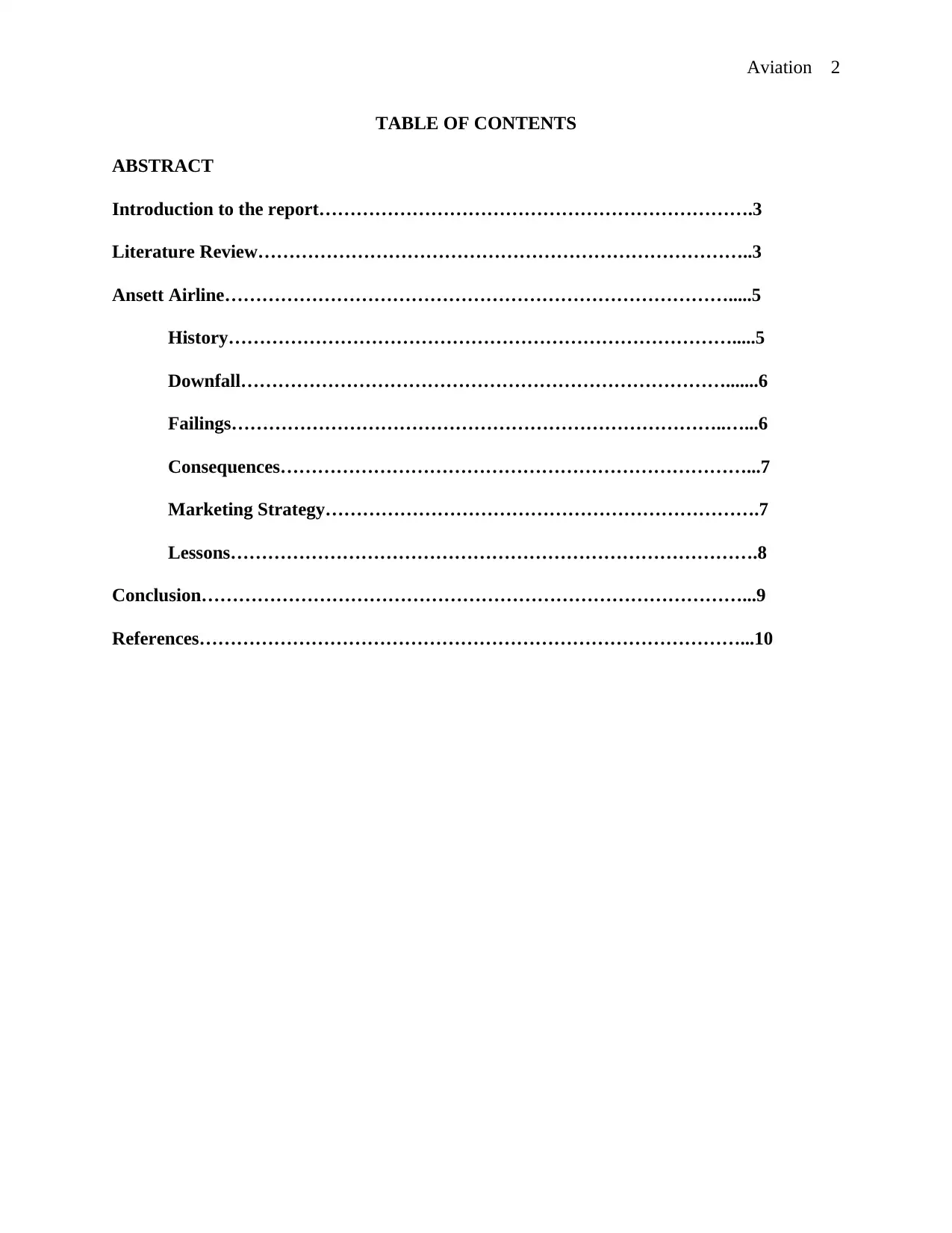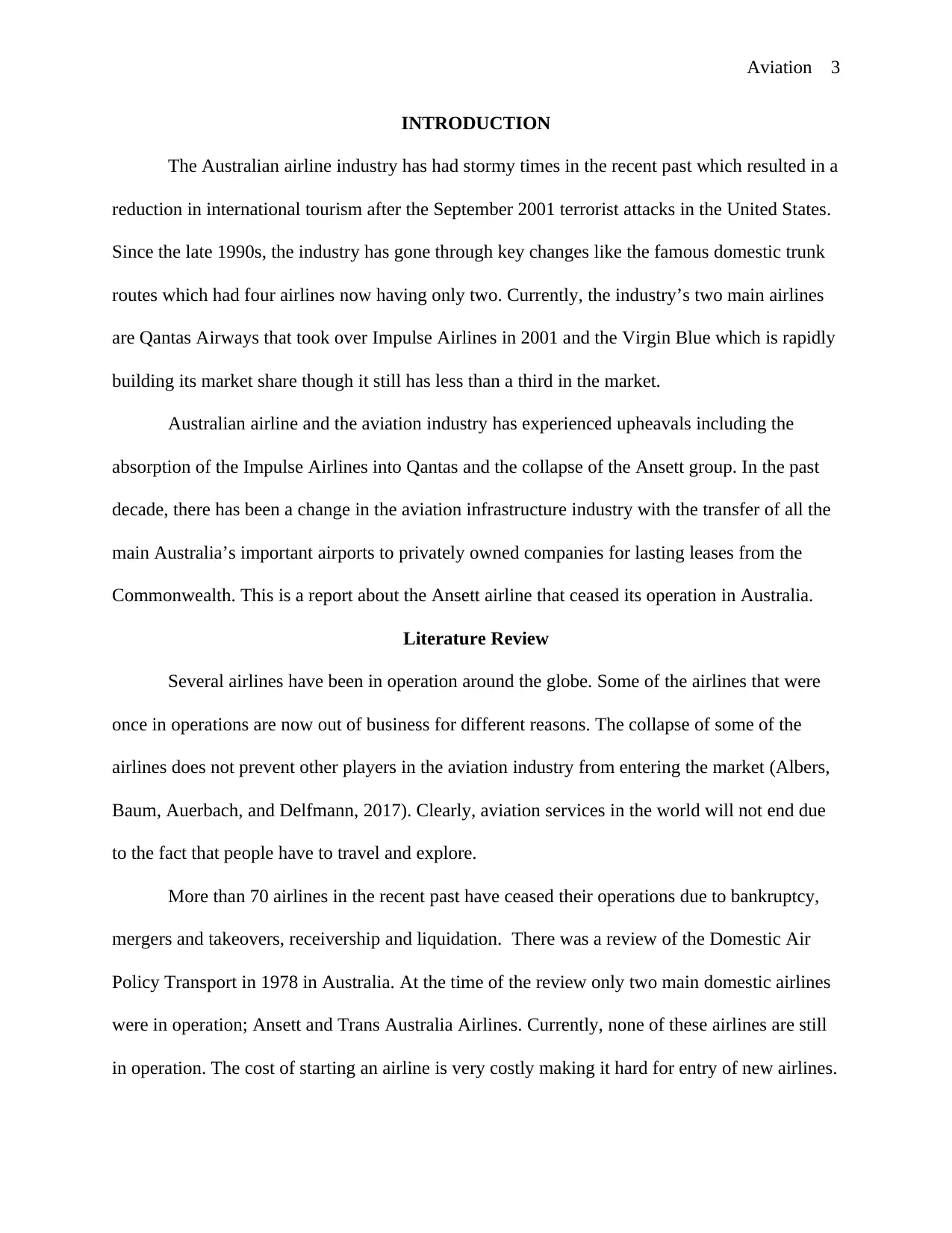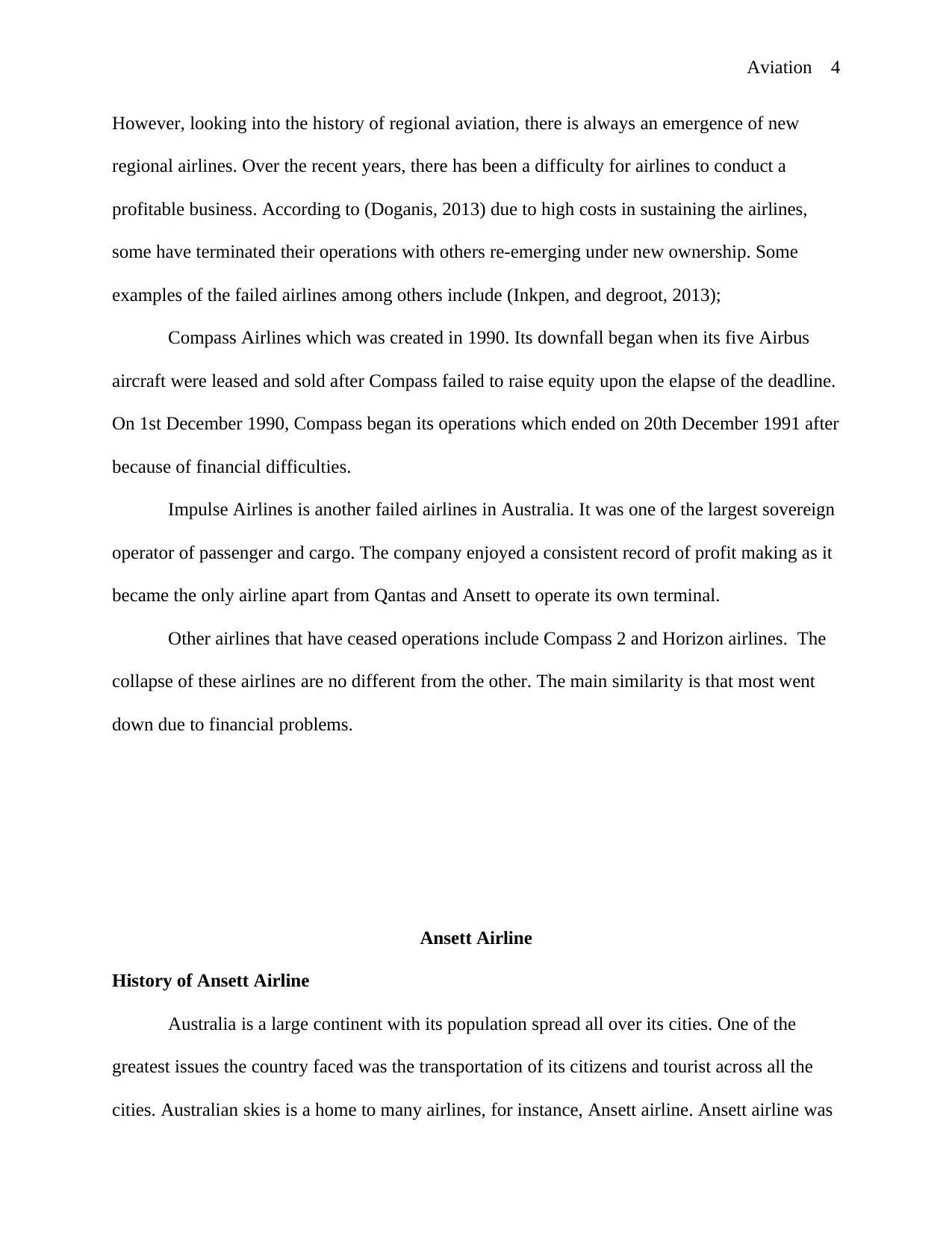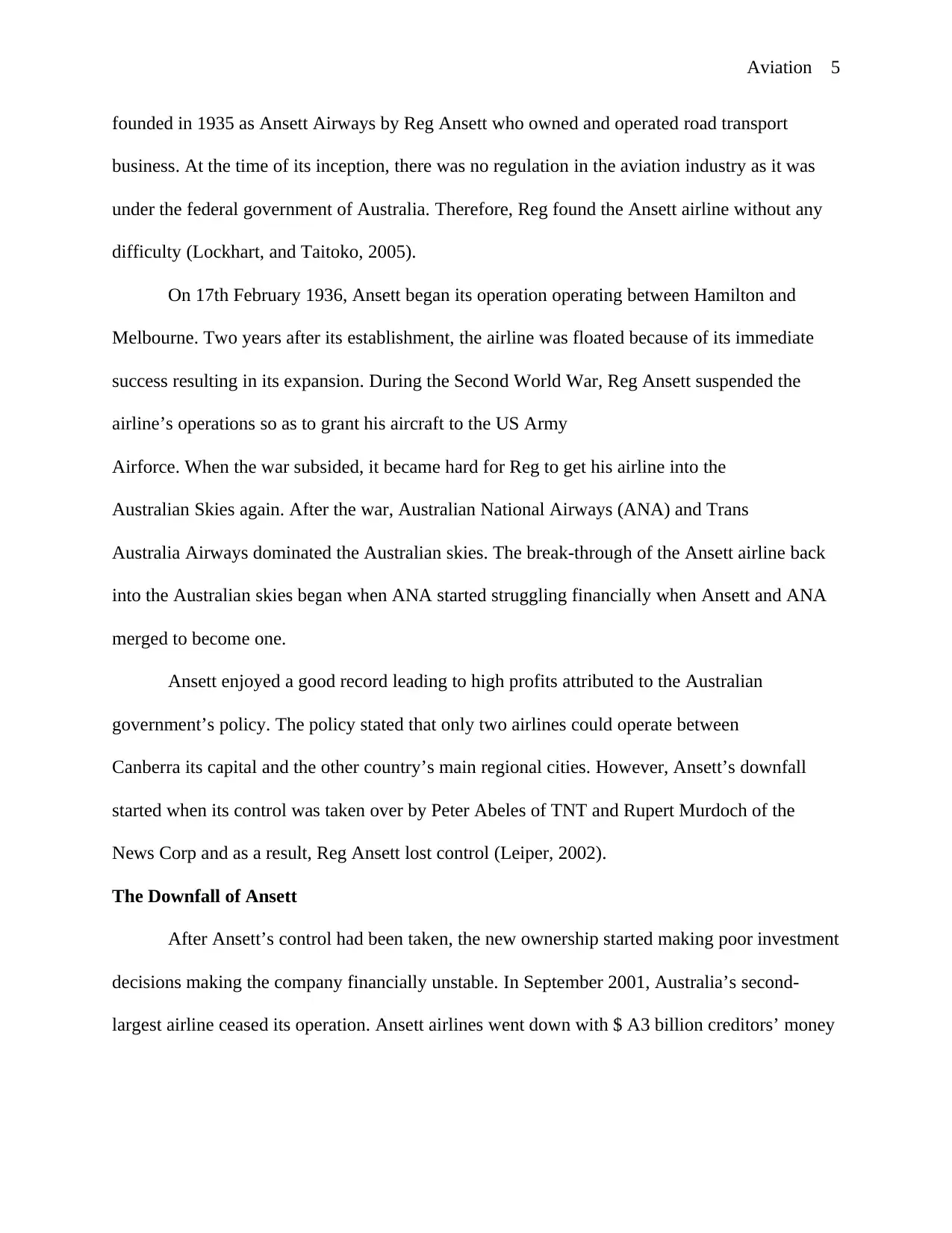Comprehensive Analysis: The Collapse of Ansett Airlines and its Impact
VerifiedAdded on 2023/03/17
|10
|1985
|83
Report
AI Summary
This report provides a comprehensive analysis of the collapse of Ansett Airlines, a prominent Australian airline. It begins with an introduction to the aviation industry, highlighting key changes and challenges, including the impact of events like the September 2001 terrorist attacks. The report then delves into Ansett's history, tracing its origins and evolution, including its merger with ANA. The core of the report examines the factors contributing to Ansett's downfall, such as poor investment decisions, changes in ownership, maintenance issues, and overpaid staff. It also explores the marketing strategies employed by Ansett and the consequences of its collapse, including job losses and stranded passengers. The report concludes by summarizing lessons learned from Ansett's failure, emphasizing the importance of strong management, financial stability, and government support in the aviation sector. The report references several academic sources to support its findings and analysis.

Aviation 1
THE COLLAPSE OF ANSETT AIRLINES
By Name
Course
Instructor
Institution
Location
Date
THE COLLAPSE OF ANSETT AIRLINES
By Name
Course
Instructor
Institution
Location
Date
Paraphrase This Document
Need a fresh take? Get an instant paraphrase of this document with our AI Paraphraser

Aviation 2
TABLE OF CONTENTS
ABSTRACT
Introduction to the report…………………………………………………………….3
Literature Review……………………………………………………………………..3
Ansett Airline……………………………………………………………………….....5
History……………………………………………………………………….....5
Downfall…………………………………………………………………….......6
Failings……………………………………………………………………..…...6
Consequences…………………………………………………………………...7
Marketing Strategy…………………………………………………………….7
Lessons………………………………………………………………………….8
Conclusion……………………………………………………………………………...9
References……………………………………………………………………………...10
TABLE OF CONTENTS
ABSTRACT
Introduction to the report…………………………………………………………….3
Literature Review……………………………………………………………………..3
Ansett Airline……………………………………………………………………….....5
History……………………………………………………………………….....5
Downfall…………………………………………………………………….......6
Failings……………………………………………………………………..…...6
Consequences…………………………………………………………………...7
Marketing Strategy…………………………………………………………….7
Lessons………………………………………………………………………….8
Conclusion……………………………………………………………………………...9
References……………………………………………………………………………...10

Aviation 3
INTRODUCTION
The Australian airline industry has had stormy times in the recent past which resulted in a
reduction in international tourism after the September 2001 terrorist attacks in the United States.
Since the late 1990s, the industry has gone through key changes like the famous domestic trunk
routes which had four airlines now having only two. Currently, the industry’s two main airlines
are Qantas Airways that took over Impulse Airlines in 2001 and the Virgin Blue which is rapidly
building its market share though it still has less than a third in the market.
Australian airline and the aviation industry has experienced upheavals including the
absorption of the Impulse Airlines into Qantas and the collapse of the Ansett group. In the past
decade, there has been a change in the aviation infrastructure industry with the transfer of all the
main Australia’s important airports to privately owned companies for lasting leases from the
Commonwealth. This is a report about the Ansett airline that ceased its operation in Australia.
Literature Review
Several airlines have been in operation around the globe. Some of the airlines that were
once in operations are now out of business for different reasons. The collapse of some of the
airlines does not prevent other players in the aviation industry from entering the market (Albers,
Baum, Auerbach, and Delfmann, 2017). Clearly, aviation services in the world will not end due
to the fact that people have to travel and explore.
More than 70 airlines in the recent past have ceased their operations due to bankruptcy,
mergers and takeovers, receivership and liquidation. There was a review of the Domestic Air
Policy Transport in 1978 in Australia. At the time of the review only two main domestic airlines
were in operation; Ansett and Trans Australia Airlines. Currently, none of these airlines are still
in operation. The cost of starting an airline is very costly making it hard for entry of new airlines.
INTRODUCTION
The Australian airline industry has had stormy times in the recent past which resulted in a
reduction in international tourism after the September 2001 terrorist attacks in the United States.
Since the late 1990s, the industry has gone through key changes like the famous domestic trunk
routes which had four airlines now having only two. Currently, the industry’s two main airlines
are Qantas Airways that took over Impulse Airlines in 2001 and the Virgin Blue which is rapidly
building its market share though it still has less than a third in the market.
Australian airline and the aviation industry has experienced upheavals including the
absorption of the Impulse Airlines into Qantas and the collapse of the Ansett group. In the past
decade, there has been a change in the aviation infrastructure industry with the transfer of all the
main Australia’s important airports to privately owned companies for lasting leases from the
Commonwealth. This is a report about the Ansett airline that ceased its operation in Australia.
Literature Review
Several airlines have been in operation around the globe. Some of the airlines that were
once in operations are now out of business for different reasons. The collapse of some of the
airlines does not prevent other players in the aviation industry from entering the market (Albers,
Baum, Auerbach, and Delfmann, 2017). Clearly, aviation services in the world will not end due
to the fact that people have to travel and explore.
More than 70 airlines in the recent past have ceased their operations due to bankruptcy,
mergers and takeovers, receivership and liquidation. There was a review of the Domestic Air
Policy Transport in 1978 in Australia. At the time of the review only two main domestic airlines
were in operation; Ansett and Trans Australia Airlines. Currently, none of these airlines are still
in operation. The cost of starting an airline is very costly making it hard for entry of new airlines.
⊘ This is a preview!⊘
Do you want full access?
Subscribe today to unlock all pages.

Trusted by 1+ million students worldwide

Aviation 4
However, looking into the history of regional aviation, there is always an emergence of new
regional airlines. Over the recent years, there has been a difficulty for airlines to conduct a
profitable business. According to (Doganis, 2013) due to high costs in sustaining the airlines,
some have terminated their operations with others re-emerging under new ownership. Some
examples of the failed airlines among others include (Inkpen, and degroot, 2013);
Compass Airlines which was created in 1990. Its downfall began when its five Airbus
aircraft were leased and sold after Compass failed to raise equity upon the elapse of the deadline.
On 1st December 1990, Compass began its operations which ended on 20th December 1991 after
because of financial difficulties.
Impulse Airlines is another failed airlines in Australia. It was one of the largest sovereign
operator of passenger and cargo. The company enjoyed a consistent record of profit making as it
became the only airline apart from Qantas and Ansett to operate its own terminal.
Other airlines that have ceased operations include Compass 2 and Horizon airlines. The
collapse of these airlines are no different from the other. The main similarity is that most went
down due to financial problems.
Ansett Airline
History of Ansett Airline
Australia is a large continent with its population spread all over its cities. One of the
greatest issues the country faced was the transportation of its citizens and tourist across all the
cities. Australian skies is a home to many airlines, for instance, Ansett airline. Ansett airline was
However, looking into the history of regional aviation, there is always an emergence of new
regional airlines. Over the recent years, there has been a difficulty for airlines to conduct a
profitable business. According to (Doganis, 2013) due to high costs in sustaining the airlines,
some have terminated their operations with others re-emerging under new ownership. Some
examples of the failed airlines among others include (Inkpen, and degroot, 2013);
Compass Airlines which was created in 1990. Its downfall began when its five Airbus
aircraft were leased and sold after Compass failed to raise equity upon the elapse of the deadline.
On 1st December 1990, Compass began its operations which ended on 20th December 1991 after
because of financial difficulties.
Impulse Airlines is another failed airlines in Australia. It was one of the largest sovereign
operator of passenger and cargo. The company enjoyed a consistent record of profit making as it
became the only airline apart from Qantas and Ansett to operate its own terminal.
Other airlines that have ceased operations include Compass 2 and Horizon airlines. The
collapse of these airlines are no different from the other. The main similarity is that most went
down due to financial problems.
Ansett Airline
History of Ansett Airline
Australia is a large continent with its population spread all over its cities. One of the
greatest issues the country faced was the transportation of its citizens and tourist across all the
cities. Australian skies is a home to many airlines, for instance, Ansett airline. Ansett airline was
Paraphrase This Document
Need a fresh take? Get an instant paraphrase of this document with our AI Paraphraser

Aviation 5
founded in 1935 as Ansett Airways by Reg Ansett who owned and operated road transport
business. At the time of its inception, there was no regulation in the aviation industry as it was
under the federal government of Australia. Therefore, Reg found the Ansett airline without any
difficulty (Lockhart, and Taitoko, 2005).
On 17th February 1936, Ansett began its operation operating between Hamilton and
Melbourne. Two years after its establishment, the airline was floated because of its immediate
success resulting in its expansion. During the Second World War, Reg Ansett suspended the
airline’s operations so as to grant his aircraft to the US Army
Airforce. When the war subsided, it became hard for Reg to get his airline into the
Australian Skies again. After the war, Australian National Airways (ANA) and Trans
Australia Airways dominated the Australian skies. The break-through of the Ansett airline back
into the Australian skies began when ANA started struggling financially when Ansett and ANA
merged to become one.
Ansett enjoyed a good record leading to high profits attributed to the Australian
government’s policy. The policy stated that only two airlines could operate between
Canberra its capital and the other country’s main regional cities. However, Ansett’s downfall
started when its control was taken over by Peter Abeles of TNT and Rupert Murdoch of the
News Corp and as a result, Reg Ansett lost control (Leiper, 2002).
The Downfall of Ansett
After Ansett’s control had been taken, the new ownership started making poor investment
decisions making the company financially unstable. In September 2001, Australia’s second-
largest airline ceased its operation. Ansett airlines went down with $ A3 billion creditors’ money
founded in 1935 as Ansett Airways by Reg Ansett who owned and operated road transport
business. At the time of its inception, there was no regulation in the aviation industry as it was
under the federal government of Australia. Therefore, Reg found the Ansett airline without any
difficulty (Lockhart, and Taitoko, 2005).
On 17th February 1936, Ansett began its operation operating between Hamilton and
Melbourne. Two years after its establishment, the airline was floated because of its immediate
success resulting in its expansion. During the Second World War, Reg Ansett suspended the
airline’s operations so as to grant his aircraft to the US Army
Airforce. When the war subsided, it became hard for Reg to get his airline into the
Australian Skies again. After the war, Australian National Airways (ANA) and Trans
Australia Airways dominated the Australian skies. The break-through of the Ansett airline back
into the Australian skies began when ANA started struggling financially when Ansett and ANA
merged to become one.
Ansett enjoyed a good record leading to high profits attributed to the Australian
government’s policy. The policy stated that only two airlines could operate between
Canberra its capital and the other country’s main regional cities. However, Ansett’s downfall
started when its control was taken over by Peter Abeles of TNT and Rupert Murdoch of the
News Corp and as a result, Reg Ansett lost control (Leiper, 2002).
The Downfall of Ansett
After Ansett’s control had been taken, the new ownership started making poor investment
decisions making the company financially unstable. In September 2001, Australia’s second-
largest airline ceased its operation. Ansett airlines went down with $ A3 billion creditors’ money

Aviation 6
necessitating it to be placed under administration. At the time of the collapse, 1600 employees
lost their jobs.
Additionally, an estimated 47,000 passengers waiting for their flights could not travel as
there were no planes to board. The passengers had their tickets at hand. There was anger and
confusion among the passengers, the staff with everyone looking for who to blame. Reports
emerged in the media that the management is to blame.
Failings of Ansett
Up to 1980s, Ansett was performing well in terms of profit making and its operation
rising to be the second largest airline in Australia. However, the following are the reasons that
led to its downfall according to (Weller, 2009).
• Change of Ownership
In 1979, the original owner and founder of Ansett; Reg lost control to Peter Abeles and
Rupert Murdoch who made poor investment decisions that saw the company go into financial
problems.
• Take Over
After the change of ownership which made the company go into financial problems, there
was the need to be placed under new companies. Due to anti-monopoly rules, Ansett –Australia
and Ansett New Zealand separated where Ansett Australia came under the management of Air
New Zealand while Ansett New Zealand became a property of News Corp.
• Maintenance
Ansett airlines had problems in maintaining their aircraft after the original owner lost
control of it. This failure led to its downfall (Kinnison, and Siddiqui, 2012).
• Lack of Government Support
necessitating it to be placed under administration. At the time of the collapse, 1600 employees
lost their jobs.
Additionally, an estimated 47,000 passengers waiting for their flights could not travel as
there were no planes to board. The passengers had their tickets at hand. There was anger and
confusion among the passengers, the staff with everyone looking for who to blame. Reports
emerged in the media that the management is to blame.
Failings of Ansett
Up to 1980s, Ansett was performing well in terms of profit making and its operation
rising to be the second largest airline in Australia. However, the following are the reasons that
led to its downfall according to (Weller, 2009).
• Change of Ownership
In 1979, the original owner and founder of Ansett; Reg lost control to Peter Abeles and
Rupert Murdoch who made poor investment decisions that saw the company go into financial
problems.
• Take Over
After the change of ownership which made the company go into financial problems, there
was the need to be placed under new companies. Due to anti-monopoly rules, Ansett –Australia
and Ansett New Zealand separated where Ansett Australia came under the management of Air
New Zealand while Ansett New Zealand became a property of News Corp.
• Maintenance
Ansett airlines had problems in maintaining their aircraft after the original owner lost
control of it. This failure led to its downfall (Kinnison, and Siddiqui, 2012).
• Lack of Government Support
⊘ This is a preview!⊘
Do you want full access?
Subscribe today to unlock all pages.

Trusted by 1+ million students worldwide

Aviation 7
• Overpaid Staff
Ansett airlines offered their employees’ huge salaries that saw it loose an estimated
A$1.3 daily.
Immediate Consequences of the Collapse of Ansett
Loss of Jobs
Approximately 1600 employees of Ansett airlines were left jobless.
Stranded Passengers
The collapse of Ansett left many passengers stranded. Many passengers were left not
knowing what to do as they already had purchased plane tickets but there were no planes to
board.
Ansett’s Marketing Strategy
Putting the right product in the right place at an appropriate price and at the right time is
what goes through the mind of any entrepreneur. For every product or service, achieving a good
market mix will enable it to prosper in the market. The proper market mix consists of the 4Ps;
Product or service, place, price, and promotion. In ensuring that the service prospers in the
market, Reg Ansett applied the 4Ps.
Product
Having been involved in the road transport business, Reg saw an opportunity in the
aviation industry and decided to come up with an airline that will ensure fast and efficient
transportation of people across all the cities in Australia. He named it Ansett airlines and branded
it Ansett. This service met the needs of Australian citizens as it provided a faster way of
transport.
Place
• Overpaid Staff
Ansett airlines offered their employees’ huge salaries that saw it loose an estimated
A$1.3 daily.
Immediate Consequences of the Collapse of Ansett
Loss of Jobs
Approximately 1600 employees of Ansett airlines were left jobless.
Stranded Passengers
The collapse of Ansett left many passengers stranded. Many passengers were left not
knowing what to do as they already had purchased plane tickets but there were no planes to
board.
Ansett’s Marketing Strategy
Putting the right product in the right place at an appropriate price and at the right time is
what goes through the mind of any entrepreneur. For every product or service, achieving a good
market mix will enable it to prosper in the market. The proper market mix consists of the 4Ps;
Product or service, place, price, and promotion. In ensuring that the service prospers in the
market, Reg Ansett applied the 4Ps.
Product
Having been involved in the road transport business, Reg saw an opportunity in the
aviation industry and decided to come up with an airline that will ensure fast and efficient
transportation of people across all the cities in Australia. He named it Ansett airlines and branded
it Ansett. This service met the needs of Australian citizens as it provided a faster way of
transport.
Place
Paraphrase This Document
Need a fresh take? Get an instant paraphrase of this document with our AI Paraphraser

Aviation 8
According to this strategy, one needs to establish where it is easier for customers to
access the product. Considering that Australia as a continent consists of many cities wide apart,
there was a need to establish a connection between the cities. Reg established the airline to
connect the cities making the country look smaller.
Price
In setting the price of every business, one has to compare with other same service
providers. Price plays a critical role in every marketing plan. This will enable a healthy
competition and a price point that is friendly to the customer.
Promotion
Promotion of a product or a service ensures that the service is well known the consumers.
Ansett uses advertising agencies like magazines and televisions.
Lessons Learnt on the Collapse of Ansett.
A change in the original owner may result in the downfall of a business.
Government plays a critical part in services such as the transport sector
Conclusion
As evident in the above report, the aviation industry involves collapse and emergence of
other airlines. A collapse in one airline leads to an emergence of another. The main reason for
the collapse of many airlines is bankruptcy and takeovers. Change in management also
contributes to the downfall of a company. The government plays a greater role in the operation
of the country’s airline. In conclusion, Ansett airline could not have ceased its operation were it
not for a change in management and financial problems.
According to this strategy, one needs to establish where it is easier for customers to
access the product. Considering that Australia as a continent consists of many cities wide apart,
there was a need to establish a connection between the cities. Reg established the airline to
connect the cities making the country look smaller.
Price
In setting the price of every business, one has to compare with other same service
providers. Price plays a critical role in every marketing plan. This will enable a healthy
competition and a price point that is friendly to the customer.
Promotion
Promotion of a product or a service ensures that the service is well known the consumers.
Ansett uses advertising agencies like magazines and televisions.
Lessons Learnt on the Collapse of Ansett.
A change in the original owner may result in the downfall of a business.
Government plays a critical part in services such as the transport sector
Conclusion
As evident in the above report, the aviation industry involves collapse and emergence of
other airlines. A collapse in one airline leads to an emergence of another. The main reason for
the collapse of many airlines is bankruptcy and takeovers. Change in management also
contributes to the downfall of a company. The government plays a greater role in the operation
of the country’s airline. In conclusion, Ansett airline could not have ceased its operation were it
not for a change in management and financial problems.

Aviation 9
REFERENCES
Albers, S., Baum, H., Auerbach, S. and Delfmann, W., 2017. Strategic management in
the aviation industry. Routledge.
Doganis, R., 2013. Flying off course: The economics of international airlines. Routledge.
Inkpen, A.C. and DEGROOT, V., 2013. Southwest airlines. Caso pedagógico.
Kinnison, H.A. and Siddiqui, T., 2012. Aviation maintenance management.
Leiper, N., 2002. Why Ansett Airlines failed and how to prevent it happening again.
Current Issues in Tourism, 5(2), pp.134-148.
Lockhart, J.C. and Taitoko, M., 2005. An examination of shareholder–stakeholder
governance tension: A case study of the collapses of Ansett Holdings and Air
REFERENCES
Albers, S., Baum, H., Auerbach, S. and Delfmann, W., 2017. Strategic management in
the aviation industry. Routledge.
Doganis, R., 2013. Flying off course: The economics of international airlines. Routledge.
Inkpen, A.C. and DEGROOT, V., 2013. Southwest airlines. Caso pedagógico.
Kinnison, H.A. and Siddiqui, T., 2012. Aviation maintenance management.
Leiper, N., 2002. Why Ansett Airlines failed and how to prevent it happening again.
Current Issues in Tourism, 5(2), pp.134-148.
Lockhart, J.C. and Taitoko, M., 2005. An examination of shareholder–stakeholder
governance tension: A case study of the collapses of Ansett Holdings and Air
⊘ This is a preview!⊘
Do you want full access?
Subscribe today to unlock all pages.

Trusted by 1+ million students worldwide

Aviation 10
New Zealand. In Corporate Governance: Does Any Size Fit? (pp. 223-246).
Emerald Group Publishing Limited.
Weller, S., 2009. Critical events and labour mobility: relocations in the wake of the
Ansett Airlines collapse. Geographical Research, 47(3), pp.242-255.
New Zealand. In Corporate Governance: Does Any Size Fit? (pp. 223-246).
Emerald Group Publishing Limited.
Weller, S., 2009. Critical events and labour mobility: relocations in the wake of the
Ansett Airlines collapse. Geographical Research, 47(3), pp.242-255.
1 out of 10
Related Documents
Your All-in-One AI-Powered Toolkit for Academic Success.
+13062052269
info@desklib.com
Available 24*7 on WhatsApp / Email
![[object Object]](/_next/static/media/star-bottom.7253800d.svg)
Unlock your academic potential
Copyright © 2020–2025 A2Z Services. All Rights Reserved. Developed and managed by ZUCOL.




